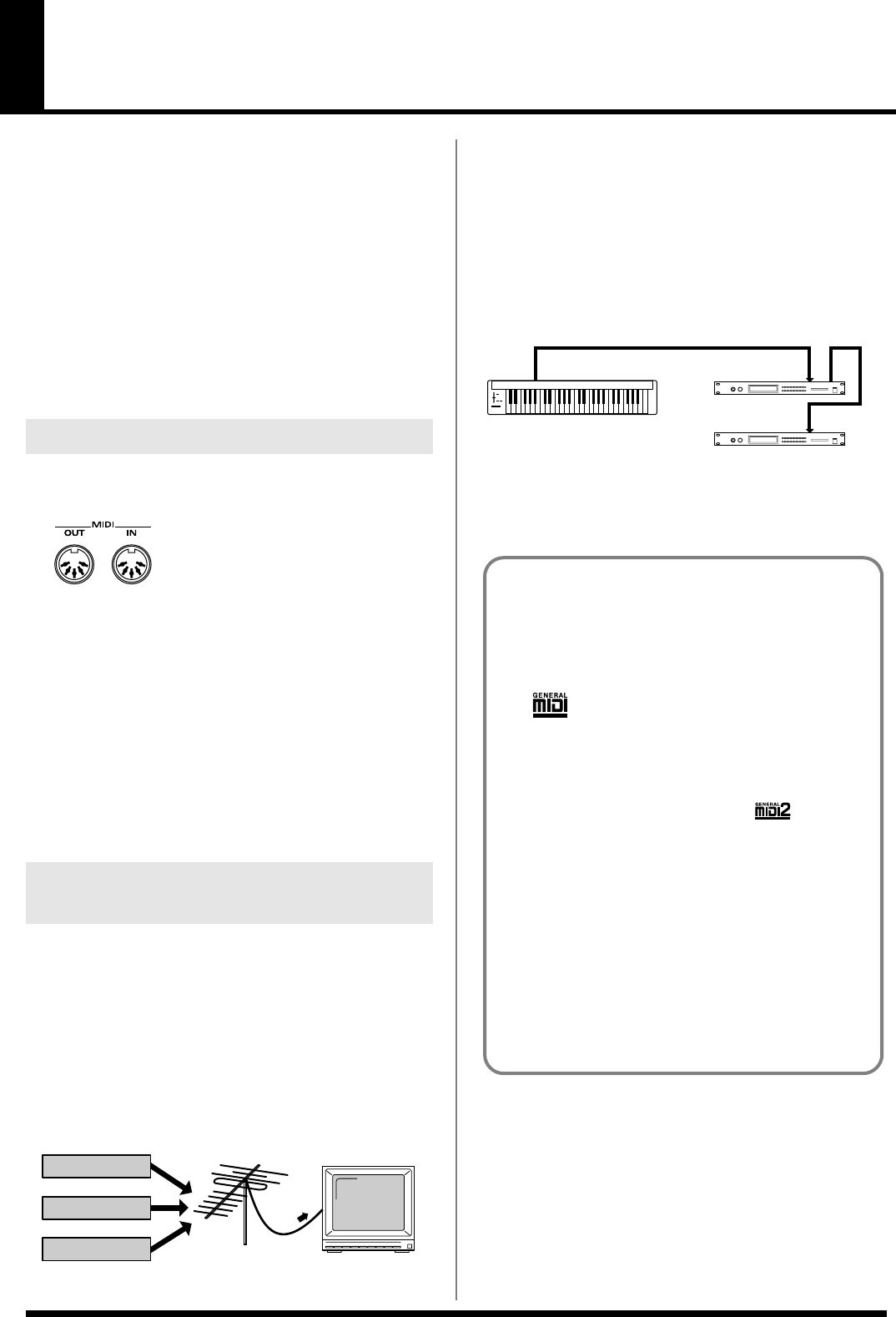
209
About MIDI
MIDI (Musical Instruments Digital Interface)
is a standard
specification that allows musical data to be exchanged between
electronic musical instruments and computers. MIDI With a MIDI
cable connecting MIDI devices that are equipped with MIDI
connectors, you can play multiple instruments with a single
keyboard, have multiple MIDI instruments perform in ensemble,
program the settings to change automatically to match the
performance as the song progresses, and more.
If you mainly use the JUNO-G as a standalone keyboard instrument,
you may really not need to know much at all about MIDI.
However, the following MIDI-related information is provided so
you can play the JUNO-G using an external MIDI device, or master
other advanced techniques.
The JUNO-G is equipped with the three types of MIDI connectors,
each which works differently.
fig.MidiCon
MIDI IN Connector
This connector receives MIDI messages that are transmitted from
external MIDI devices. The JUNO-G can receive these messages to
play notes or select sounds, etc.
MIDI OUT Connector
This connector transmits MIDI messages to external MIDI devices.
The JUNO-G’s MIDI OUT connector is used for sending the
performance data of the keyboard controller section as well as data
used for saving various settings.
MIDI transmits many types of data over a single MIDI cable. This is
made possible by the concept of
MIDI channels
. MIDI channels
allow messages intended for a given instrument to be distinguished
from messages intended for another instrument. In some ways,
MIDI channels are similar to television channels. By changing the
channel on a television set, you can view the programs that are being
broadcast by different stations. In the same way, MIDI also allows a
device to select the information intended for that device out of the
variety of information that is being transmitted to it.
fig.MidiCh1.e
MIDI uses sixteen channels; 1 through 16. Set the receiving device so
that it will receive only the channel that it needs to receive.
Example:
Set the JUNO-G to send Channel 1 and Channel 2, then set sound
module A to receive only Channel 1 and sound module B only
Channel 2. With this setup, you can get an ensemble performance,
with, for example, a guitar sound from sound module A and bass
from sound module B.
fig.MidiCh2.e
When used as a sound module, the JUNO-G can receive on up to
sixteen MIDI channels. Sound modules like the JUNO-G which can
receive multiple MIDI channels simultaneously to play different
sounds on each channel are called multi-timbral sound modules.
About MIDI Connectors
MIDI Channels and Multi-timbral
Sound Generators
The cable from the antenna carries the TV
signals from many broadcast stations.
The TV is set to the channel of the station
you wish to watch.
Station B
Station A
Station C
MIDI OUT MIDI IN MIDI THRU
MIDI IN
Receive channel: 1
Receive channel: 2
Sound
Module
A
Sound
Module
B
Transmit channel: 1, 2
MIDI keyboard
General MIDI
General MIDI is a set of recommendations which seeks to
provide a way to go beyond the limitations of proprietary
designs, and standardize the MIDI capabilities of sound
generating devices. Sound generating devices and music files
that meet the General MIDI standard bear the General MIDI
logo ( ). Music files bearing the General MIDI logo can be
played back using any General MIDI sound generating unit to
produce essentially the same musical performance.
General MIDI 2
The upwardly compatible General MIDI 2 ( )
recommendations pick up where the original General MIDI left
off, offering enhanced expressive capabilities, and even greater
compatibility. Issues that were not covered by the original
General MIDI recommendations, such as how sounds are to be
edited, and how effects should be handled, have now been
precisely defined. Moreover, the available sounds have been
expanded. General MIDI 2 compliant sound generators are
capable of reliably playing back music files that carry either the
General MIDI or General MIDI 2 logo.
In some cases, the conventional form of General MIDI, which
does not include the new enhancements, is referred to as
“General MIDI 1” as a way of distinguishing it from General
MIDI 2.
JUNO-G_e.book 209 ページ 2006年2月13日 月曜日 午後2時44分


















